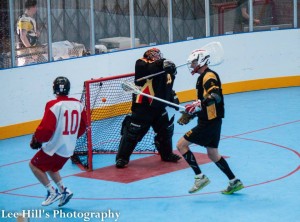How does box lacrosse differ from field lacrosse?
 I’ve been playing field lacrosse in the UK since 1991. The Tasko Cup was my first experience of watching, let alone playing box lacrosse. Here’s my experience of the tournament.
I’ve been playing field lacrosse in the UK since 1991. The Tasko Cup was my first experience of watching, let alone playing box lacrosse. Here’s my experience of the tournament.
If I could turn back time, I’d love to be in my 20’s again with loads of energy, no injury niggles and to have access to the Solent Arena to play box lacrosse. The venue, although very new and in places, unfinished, is perfect for box lacrosse. The floor area is smaller than that played in the NLL or in Radotin (Prague) but that lent itself to even faster, more intense play. The build quality of the rink is superb. The floor is pan flat but grippy. The boards flexed under impact so while this made a great crunching sound, no-one actually got hurt if crushed into them. Picking up ground balls took a few minutes to get used to and encouraged proper technique, running through the ball rather than any pull-back scoops. Each team had 30 minutes on the floor to warm-up and get used to the surroundings. Then the action started with my team, Heaton Hornets against the best in Europe, LCC Radotin.
The 6-man game (goalie + 5) is nothing new for field players as it’s format for field 6-a-side tournaments. However the speed of box lacrosse is at first a blur. The first big challenge for field players is getting used to rebounds off the side boards. In field, after a shot or misplaced pass, the ball will run out of play, giving a few seconds for the defense re-organise. No such luxury in box and you could see the Radotin players react way quicker than the less experienced in winning the loose ball and setting up another attack.
Bench organisation is another new challenge for field players. The Solent Arena only has a single door for each bench – the ideal venue would have 2 doors per bench, one for the the offense and one for the defense. Getting players on and off through the door took a couple of games to master. The Hornets were running two clear lines of players; offense and defense, so we knew who was going on and when.
The 30-second shot clock rarely featured in games. The less experienced teams had trouble just keeping the ball for this amount of time. There was little space to run away from danger and turn-overs especially against Radotin lead to fast-break goals.
 I was playing in a mostly defensive role. The fact that you can get away with almost everything illegal in field lacrosse was a joy. It’s all about the cross check and being physical. It was almost impossible to throw a field check due to the extra width of players padding so few bothered. Anyone coming into the crease, with or without the ball, was cross checked. Steer dodging players into the boards and never let them get inside. Those were the basics.
I was playing in a mostly defensive role. The fact that you can get away with almost everything illegal in field lacrosse was a joy. It’s all about the cross check and being physical. It was almost impossible to throw a field check due to the extra width of players padding so few bothered. Anyone coming into the crease, with or without the ball, was cross checked. Steer dodging players into the boards and never let them get inside. Those were the basics.
What made Radotin so good? I’ve already talked about recovering rebounds off the boards. They were all about stick skills and movement off the ball. Very rarely did a Radotin player dodge with the ball. They probably could if they wanted to but instead they passed the ball, at pace, accurately around the floor, looking for team mates to get into space in front of goal, normally off picks. Three or four quick passes later a Radotin player was unmarked in front of goal with the ball with the keeper dizzy.
Compare that with the teams with mostly field lacrosse players, their goals mostly came from (very good) outside shots. With only a 4’9″ x 4′ goal to aim at, outside shots are low percentage shots in box lacrosse.